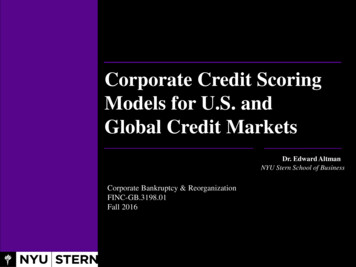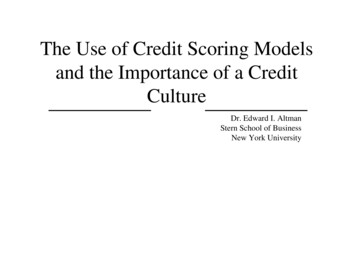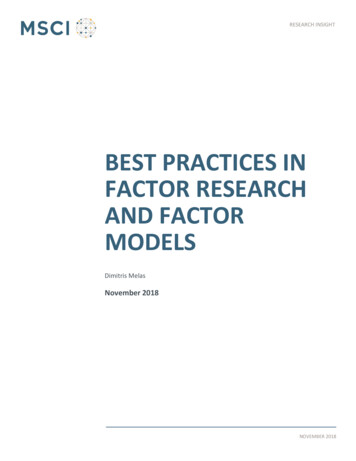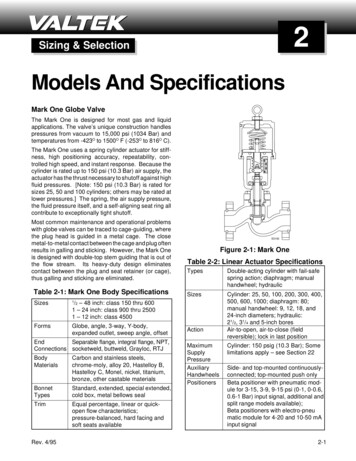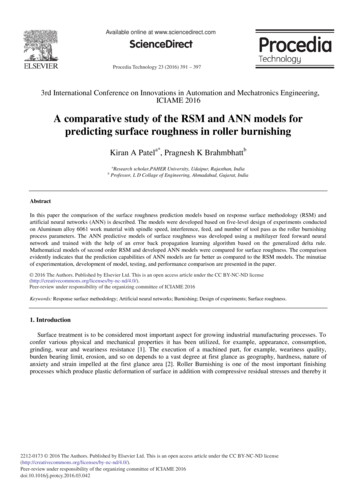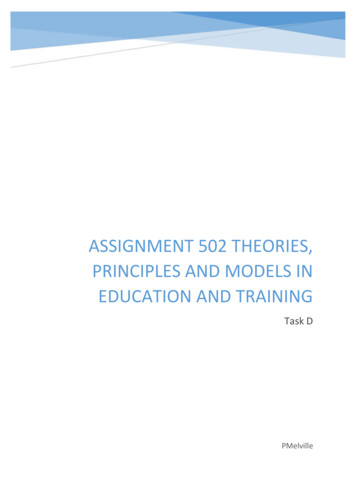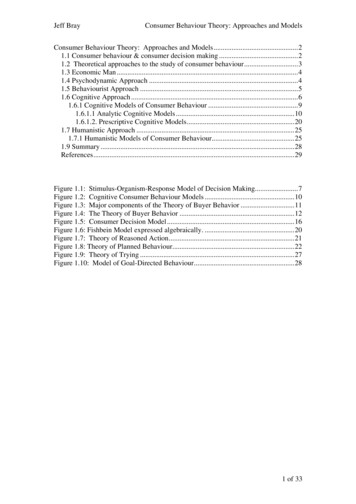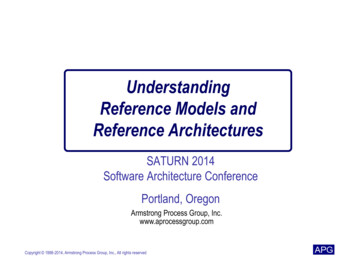
Transcription
UnderstandingReference Models andReference ArchitecturesSATURN 2014Software Architecture ConferencePortland, OregonArmstrong Process Group, Inc.www.aprocessgroup.comCopyright 1998-2014, Armstrong Process Group, Inc., All rights reserved
Objectives Discuss industry standard best practices regarding howto use reference models for categorizing architecturecontent for different purposes Planning, lifecycle management, gap analysis andenterprise-wide alignment Discuss how reference architectures are used And how they different, but related to reference models How they relate to architecture/solution building blocks(per TOGAF) Review conceptual metamodel representing theseconceptsSATURN 2014 – Understanding Reference Models and Reference ArchitecturesCopyright 1998-2014, Armstrong Process Group, Inc., All rights reserved2
About APG APG’s mission is to“Align information technology and systems engineeringcapabilities with business strategy using proven, practicalprocesses delivering world-class results.” Industry thought leader in enterprise architecture, businessmodeling, process improvement, systems and softwareengineering, requirements management, and agile methods Member and contributor to UML, SysML, SPEM, UPDM at the Object Management Group (OMG) TOGAF and ArchiMate at The Open Group Eclipse Process Framework (EPF) at the Eclipse Foundation Sparx Systems Value-Added Reseller IBM Advanced Business PartnerSATURN 2014 – Understanding Reference Models and Reference ArchitecturesCopyright 1998-2014, Armstrong Process Group, Inc., All rights reserved3
4SEI Definitions Reference model A division of functionality into elements together with thedata flow among those elements Reference architecture A reference model mapped onto software elements thatimplements the functionality defined in the reference modelSATURN 2014 – Understanding Reference Models and Reference ArchitecturesCopyright 1998-2014, Armstrong Process Group, Inc., All rights reservedSoftware Engineering InstituteSoftware Architecture Glossary
5TOGAF Definitions The terms reference architecture and reference modelare not used carefully in most literature “Reference architecture” and “reference model” havethe same relationship as “architecture” and “model” Either can exist as either generic or an organization-specificstate Typically, generic reference architectures providearchitecture team with an outline of their organizationspecific reference architecture that will be customizedfor a specific organization Does also incorporate OASIS SOA RM definitionSATURN 2014 – Understanding Reference Models and Reference ArchitecturesCopyright 1998-2014, Armstrong Process Group, Inc., All rights reservedTOGAF 9.1 Architecture RepositoryReference Library (41.3.1)
6Reference Model – OASIS An abstract framework for understanding significantrelationships among the entities of some environment For development of consistent standards or specificationssupporting that environment Consists of minimal set of unifying concepts, axioms andrelationships within particular problem domain Independent of specific standards, technologies,implementations, or other concrete details OASIS Reference Model for SOA [SOA-RM] providescommon language for understanding important features ofSOA Does not address the issues involved in constructing, using orowning a SOA-based systemSATURN 2014 – Understanding Reference Models and Reference ArchitecturesCopyright 1998-2014, Armstrong Process Group, Inc., All rights reservedOASIS Reference Model forService Oriented Architecture v1.0
7Reference Model – FEA Structure which allows modules and interfaces of a systemto be described in consistent manner Abstract framework for understanding significantrelationships among entities of some environment For development of consistent standards or specificationssupporting that environment Based on small number of unifying concepts May be used as basis for education and explaining standards tonon-specialist Not directly tied to any standards, technologies or otherconcrete implementation details Does seek to provide common semantics that can be usedunambiguously across and between different implementationsSATURN 2014 – Understanding Reference Models and Reference ArchitecturesCopyright 1998-2014, Armstrong Process Group, Inc., All rights reservedFederal Enterprise ArchitectureConsolidated Reference Model v2.3
OASIS SOA Reference Model – Service DescriptionSATURN 2014 – Understanding Reference Models and Reference ArchitecturesCopyright 1998-2014, Armstrong Process Group, Inc., All rights reservedOASIS Reference Model forService Oriented Architecture v1.08
EA TRM – Areas and CategoriesSATURN 2014 – Understanding Reference Models and Reference ArchitecturesCopyright 1998-2014, Armstrong Process Group, Inc., All rights reserved9
EA TRM – Technology Component CatalogSATURN 2014 – Understanding Reference Models and Reference ArchitecturesCopyright 1998-2014, Armstrong Process Group, Inc., All rights reserved10
EA TRM – Technology AreaSATURN 2014 – Understanding Reference Models and Reference ArchitecturesCopyright 1998-2014, Armstrong Process Group, Inc., All rights reserved11
US Department of Veterans Affairs TRMSATURN 2014 – Understanding Reference Models and Reference ArchitecturesCopyright 1998-2014, Armstrong Process Group, Inc., All rights reserved12
VA TRM Entry – JBoss ASSATURN 2014 – Understanding Reference Models and Reference ArchitecturesCopyright 1998-2014, Armstrong Process Group, Inc., All rights reserved13
OMB Federal Enterprise Architecture (FEA) Equips OMB and Federal agencies with common language and framework Describe and analyze investments Enhance collaboration Transform Federal government Consists of set of interrelated “reference models” Comprise framework for describing important elements of federal agency operations Agency investments can be better managed and leveraged across federalgovernmentSATURN 2014 – Understanding Reference Models and Reference ArchitecturesCopyright 1998-2014, Armstrong Process Group, Inc., All rights reservedFederal Enterprise Architecture (FEA) v2.3U.S. White House, Office of Management and Budget (OMB)14
FEA – Service Reference Model (SRM) Aids in recommendingservice capabilities tosupport reuse ofbusiness componentsand services acrossfederal government Service domains Customer Services Process Automation Business ManagementServices Digital Asset Services Business AnalyticalServices Back Office Services Support ServicesSATURN 2014 – Understanding Reference Models and Reference ArchitecturesCopyright 1998-2014, Armstrong Process Group, Inc., All rights reservedFederal Enterprise Architecture (FEA) v2.3U.S. White House, Office of Management and Budget (OMB)15
TOGAF Enterprise ContinuumSATURN 2014 – Understanding Reference Models and Reference ArchitecturesCopyright 1998-2014, Armstrong Process Group, Inc., All rights reserved16
17TOGAF Enterprise RepositoriesArchitecture RepositoryViewTOGAF Architecture Repositoryin ATPLArchitecture MetamodelDevelopment MethodArtifacts in landscape arestructured according eference ModelsCapabilityArchitecturesViewpoint LibraryStandards havereferenceimplementationsStandards arecomplied withStandards InformationBaseProductsReferencemodelsadopted byenterpriseTemplatesAdoptedby www.aprocessgroup.comReference LibraryBest ent d byenterpriseBusiness StandardsSolution BuildingBlocksBest practicecreatesstandardsLandscapeis ta StandardsApplication StandardsTechnology sitoryStrategicRequirementsCompliance is governedDrivers forenterpriseGovernance LogDecision darProject CapabilityRequirementsSkillsRepositoryArchitecture SATURN 2014 – Understanding Reference Models and Reference ArchitecturesCopyright 1998-2014, Armstrong Process Group, Inc., All rights reservedVisibilityandescalationSteers andmanagescapabilityArchitectureBoard
18Reference Model – Conceptual Metamodel«enumerati.RM Usage Type«enumerati.RM Model TypeMappingCategorizeGap action Lev elDomain ofInterestAbstractConcreteInstance1.*1RM Usage0.*0.*Type :RM Usage TypeChildren 0.*ModelModelReference ModelQuality Attribute0.*Parent 0.1Content ModelName :TextType :RM Model TypeChildren 0.*1.*0.*0.*Assigns CMElementsAssigned toRM ElementsParent 0.10.*RM Relationship0.*0.*0.*0.11.*CM ElementRM ElementID :TextRelated To Name :TextDescription :Text1Related From Level :Abstraction LevelIs Assignable :Yes/No1 Is Managed :Yes/No/Is Leaf :Yes/NoName :TextLevel :Abstraction LevelModel User :UserManaged Model ElementIs Managed :Yes/No0.11Owner :Organization UnitManager :PersonStatus :Lifecycle State1Lifecycle ModelQuality Attribute ValueType :Quality Attribute1.*ArchitectureBuilding Block0.*0.*Solution BuildingBlock0.*0.*OperationalBuilding BlockSATURN 2014 – Understanding Reference Models and Reference ArchitecturesCopyright 1998-2014, Armstrong Process Group, Inc., All rights reservedLifecycle StateCM Relationship10.*Related From0.*Building BlockRelated To0.*0.*
Reference Architecture – OASIS Definition An architectural design pattern that indicates how an abstractset of elements and relationships realizes predetermined set ofrequirements in domain of interest Independent of technologies, protocols, and products that are used toimplement specific solutions Differs from reference model in that reference models describeimportant concepts and relationships in the domain Shows more complete picture that includes showing what isinvolved in realizing the modeled entities Independent of particular solution but instead applies to class ofsolutions Possible to define at many levels of detail or abstraction fordifferent purposes Not a concrete architecture, depending on requirements beingaddressed by the reference architecture Generally will not completely specify all the technologies, componentsand their relationships in sufficient detail to enable direct implementationSATURN 2014 – Understanding Reference Models and Reference ArchitecturesCopyright 1998-2014, Armstrong Process Group, Inc., All rights reservedOASIS Reference Architecture Foundation forService Oriented Architecture v1.019
20OASIS RA-RM ContextSATURN 2014 – Understanding Reference Models and Reference ArchitecturesCopyright 1998-2014, Armstrong Process Group, Inc., All rights reservedOASIS Reference Model forService Oriented Architecture v1.0
21OASIS RA – Social StructureSATURN 2014 – Understanding Reference Models and Reference ArchitecturesCopyright 1998-2014, Armstrong Process Group, Inc., All rights reservedOASIS Reference Model forService Oriented Architecture v1.0
Open Group SOA Reference ArchitectureSATURN 2014 – Understanding Reference Models and Reference ArchitecturesCopyright 1998-2014, Armstrong Process Group, Inc., All rights reservedOpen Group SOA Reference Architecture22
OG SOA RA – Operational Layer ElementsSATURN 2014 – Understanding Reference Models and Reference ArchitecturesCopyright 1998-2014, Armstrong Process Group, Inc., All rights reservedOpen Group SOA Reference Architecture23
OG SOA RA – Operational Layer – RelationshipsSATURN 2014 – Understanding Reference Models and Reference ArchitecturesCopyright 1998-2014, Armstrong Process Group, Inc., All rights reservedOpen Group SOA Reference Architecture24
Architecture Description StandardSATURN 2014 – Understanding Reference Models and Reference ArchitecturesCopyright 1998-2014, Armstrong Process Group, Inc., All rights reservedISO/IEC 42010:2011 (f/k/a IEEE 1471)25
Reference Configuration – Conceptual MetamodelPrincipleArchitectureDescription0.*RC UsageName :TextStatement :TextRationale :TextImplications :TextType :RC Usage TypeGoalReference ConfigurationParent 0.10.*Type :RC TypeContent ModelQuality AttributeName :Text0.*Level :Abstraction LevelModel User :User0.*0.*Children 0.*Requirement0.*0.*1.*CM ElementIs Managed :Yes/NoRelated ToRC RelationshipRC Element0.*1Related FromQuality Attribute Value0.* Type :Quality Attribute0.*Assigns CMElements0.*1Assigned to RMElements0.*SATURN 2014 – Understanding Reference Models and Reference ArchitecturesCopyright 1998-2014, Armstrong Process Group, Inc., All rights reservedRM Element«enumeration»RC TypeArchitectureDesignImplementation«enumerati.RC Usage TypeConformanceDeriveInstantiate26
Conclusion Reference models used to represent properties of elementsin a domain of interest Reference architectures represent configurations ofreference model elements created to address specificrequirements based on specific set of principles Could be considered a set of patterns or a pattern language Content model elements can be mapped to referencemodel elements for categorization/organization purposes Sometimes used for managing/governing groups of relatedcontent model elements Content model elements can be configured instantiations ofreference architecturesSATURN 2014 – Understanding Reference Models and Reference ArchitecturesCopyright 1998-2014, Armstrong Process Group, Inc., All rights reserved27
28Q&Ahttp://www.aprocessgroup.comThanks for your attentionand participation!"APG", the APG logo, "proven practical process" (and its graphic representation), ATPL, EA-In-A-Box are trademarks of Armstrong Process Group,Inc.The Open Group, The Open Group Architecture Framework, TOGAF, and ArchiMate are trademarks or registered trademarks of The Open Group inthe United States and other countries.Object Management Group, OMG, Model Driven Architecture, MDA, OMG SysML, Unified Modeling Language, and UML are trademarks or registeredtrademarks of the Object Management Group, Inc. in the United States and other countries.Sparx Systems and Enterprise Architect are trademarks or registered trademarks of Sparx Systems Pty Ltd.Other company, product, or service names may be trademarks or service marks of others.SATURN 2014 – Understanding Reference Models and Reference ArchitecturesCopyright 1998-2014, Armstrong Process Group, Inc., All rights reserved
TOGAF Definitions The terms reference architecture and reference model are not used carefully in most literature “Reference architecture” and “reference model” have the same relationship as “architecture” and “model” Either can ex



